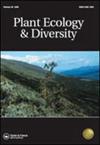Plant speciation in the Quaternary
IF 1.6
4区 生物学
Q2 PLANT SCIENCES
引用次数: 18
Abstract
ABSTRACT Background There are conflicting views between palaeobotanists and plant systematists/evolutionary biologists regarding the occurrence of plant speciation in the Quaternary. Palaeobotanists advocate that Quaternary speciation was rare despite opposing molecular phylogenetic evidence, the extent of which appears underappreciated. Aims To document, describe and discuss evidence for Quaternary plant speciation across different geographical regions based on dated molecular phylogenies and related studies. Methods From a search of the literature, we compiled a selection mainly of dated molecular phylogenies from all continents (except Antarctica) and from all major climate zones. Results Molecular phylogenetic analyses and related studies show that Quaternary plant speciation and radiations occurred frequently and that in many instances Quaternary climatic oscillations were likely important drivers of them. In all geographical regions studied, Quaternary plant speciation and radiations were particularly evident in mountainous areas and arid regions, and were also prevalent on all major oceanic archipelagos. Conclusions Based on our survey of the molecular phylogenetic and related literature we propose there is now overwhelming evidence that plant speciation and radiations were ubiquitous during the Quaternary. We therefore reject the view of palaeobotanists that plant speciation was rare during this period and briefly discuss possible reasons for this discrepancy.第四纪植物形态
背景关于第四纪植物物种形成的发生,古植物学家和植物系统学家/进化生物学家之间存在着相互矛盾的观点。古植物学家主张第四纪物种形成是罕见的,尽管有相反的分子系统发育证据,其程度似乎未得到充分认识。目的记录、描述和讨论基于分子系统发育和相关研究的第四纪植物物种形成的证据。方法通过文献检索,我们编制了主要来自各大洲(南极洲除外)和所有主要气候带的分子系统发育的年代选择。结果分子系统发育分析和相关研究表明,第四纪植物物种形成和辐射频繁发生,在许多情况下,第四纪气候振荡可能是其重要驱动因素。在所研究的所有地理区域中,第四纪植物物种形成和辐射在山区和干旱地区特别明显,在所有主要的海洋群岛上也普遍存在。基于对分子系统发育和相关文献的研究,我们认为现在有大量证据表明第四纪植物物种形成和辐射是普遍存在的。因此,我们反对古植物学家的观点,即在这一时期植物物种形成很少,并简要讨论了这种差异的可能原因。
本文章由计算机程序翻译,如有差异,请以英文原文为准。
求助全文
约1分钟内获得全文
求助全文
来源期刊

Plant Ecology & Diversity
PLANT SCIENCES-
CiteScore
3.30
自引率
0.00%
发文量
26
审稿时长
3 months
期刊介绍:
Plant Ecology and Diversity is an international journal for communicating results and novel ideas in plant science, in print and on-line, six times a year. All areas of plant biology relating to ecology, evolution and diversity are of interest, including those which explicitly deal with today''s highly topical themes, such as biodiversity, conservation and global change. We consider submissions that address fundamental questions which are pertinent to contemporary plant science. Articles concerning extreme environments world-wide are particularly welcome.
Plant Ecology and Diversity considers for publication original research articles, short communications, reviews, and scientific correspondence that explore thought-provoking ideas.
To aid redressing ‘publication bias’ the journal is unique in reporting, in the form of short communications, ‘negative results’ and ‘repeat experiments’ that test ecological theories experimentally, in theoretically flawless and methodologically sound papers. Research reviews and method papers, are also encouraged.
Plant Ecology & Diversity publishes high-quality and topical research that demonstrates solid scholarship. As such, the journal does not publish purely descriptive papers. Submissions are required to focus on research topics that are broad in their scope and thus provide new insights and contribute to theory. The original research should address clear hypotheses that test theory or questions and offer new insights on topics of interest to an international readership.
 求助内容:
求助内容: 应助结果提醒方式:
应助结果提醒方式:


